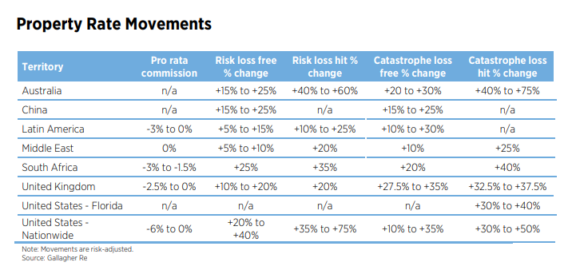

Capacity was more readily available during the midyear renewals, which brokers described as “orderly,” in comparison to the turbulent January renewals. At the same time, prices saw some moderating trends while reinsurers continued to maintain underwriting discipline, according to reports published by Aon, Gallagher Re and Guy Carpenter.
Aon said property-catastrophe capacity at midyear was ample, with top layers on some U.S. national programs oversubscribed. “Midyear renewals saw signs of reinsurer appetite for catastrophe returning, with ample capacity for U.S. and Florida,” according to Aon’s report titled Reinsurance Market Dynamics June and July 2023, which noted that “a sense of order returned to renewals at midyear,” after a “turbulent” Jan. 1 renewal period.
“Additional capacity behind established relationships helped increase supply, while several reinsurers began to deploy increased shares on programs,” Aon said, explaining that reinsurer appetite was strongest at the top end of programs, and was more constrained in the lower-middle layers of catastrophe programs.
Reinsurer capital increased by 5 percent, or $30 billion, to $605 billion in the first quarter of 2023, “as earnings were strong and catastrophe bond markets rebounded. While capacity has not returned to 2022 midyear levels, reinsurers are showing a willingness to support current terms and grow in target areas,” Aon added.
“Supply and demand showed signs of coming more into balance, particularly for programs that were perceived by reinsurers to be well structured and appropriately priced,” said Gallagher Re in its report titled “1st View: Continuing Discipline – July 2023,” which focused on the July renewals while the Aon and Guy Carpenter reports covered both the June and July renewals. (The majority of property catastrophe accounts in Florida and Australia renew at June 1 and July 1).
This growing market equilibrium has created a “more orderly” July renewal, which Gallagher Re attributed to new capital entering the market, via capital raising by traditional reinsurers as well as insurance linked securities (ILS) funds, along with moderated demand from buyers through a combination of increased retentions and deferring purchases of additional limit.
Reinsurance broker Guy Carpenter agreed that additional capacity and increased appetite entered the property market at midyear but “the increased capacity remained highly disciplined around attachment points, pricing and coverage.”
“While property pricing saw continued risk-adjusted rate increases in many segments, the average change moderated from January 1,” according to Carpenter in its market briefing.
Property Prices
Addressing property pricing trends, Aon said, risk-adjusted rate increases for U.S. and Florida property catastrophe covers averaged between 25 and 35 percent, although the level of increase is slowing in comparison to the January renewals.
Guy Carpenter noted that global property catastrophe reinsurance risk-adjusted rate increases ranged from +10 percent to +50 percent, with loss-affected clients often seeing higher prices. “In the U.S., property-catastrophe reinsurance risk-adjusted rate increases were on average the highest in 17 years, with loss-free accounts generally up +20 percent to +50 percent.
“Price adequacy across lines and supportable structures are expected to continue to drive sufficient capacity levels. For cedents, higher levels of retained risk across the business in 2023 will most likely impact volatility in 2024, necessitating strategic portfolio management,” said Dean Klisura, president & CEO of Guy Carpenter, in a statement.
“With the improved terms and conditions available in the reinsurance market, some existing reinsurers are leaning into the hardening market, committing more of their existing capital, as well as any new capital they are raising, to reinsurance,” commented Tom Wakefield, global CEO Gallagher Re. “However, in contrast to other historic hard markets, there are limited signs of completely new reinsurance entities forming and the current trend is one of consolidation into fewer, larger reinsurance entities—which, in the absence of any major losses, points towards pricing stability.”
Regarding structural changes driven by reinsurers, Gallagher Re noted that reinsurers have continued to move from surplus to quota shares, while increased retentions were commonly seen in excess-of-loss programs, which was consistent with the January renewals.
The brokers went on to discuss some of the key trends seen during the midyear renewals. A selection of some of their comments follows here by line of business and alphabetically by broker.
All three brokers commented on the fact that catastrophe bonds experienced a record first half in 2023.
Aon said the catastrophe bond market has been the main contributor to ILS capital growth, with overall ILS capital totaling $100 billion as of March 31, 2023. “The rebound in the catastrophe bond market this year alleviated some demand-supply pressures at midyear, with catastrophe bond capacity at an all-time high,” according to Aon.
“The catastrophe bond market has grown with outstanding notional increasing by $3.8 billion in 2023 to date and continues to trend upward as widening spreads and heightened rates make insurance-linked securities an increasingly attractive asset class for investors,” Aon continued.
Carpenter said, by June 30, 41 different catastrophe bonds were placed in the market for approximately US$9.2 billion in limit, “taking the total outstanding notional amount to more than $37.8 billion.”
In comparison, Guy Carpenter added, the total limit placed during full year 2022 was $9.3 billion and the average limit placed in the first half of the last five years was US$6.5 billion.
Gallagher Re said one of the more encouraging signs for the market has been the ability of some ILS funds to attract new investments, particularly into more liquid catastrophe bond strategies. “The strong returns achieved by ILS funds in 2023 to date have undoubtedly assisted the growing investor interest, and this in turn has supported an increase in the number of new bonds being issued…”
Gallagher Re said ILS investors also have begun to refocus on ILS for other perils such as cyber and casualty.
This article was originally published by Insurance Journal. Reporter L.S. Howard is the International and Reinsurance editor for Insurance Journal.